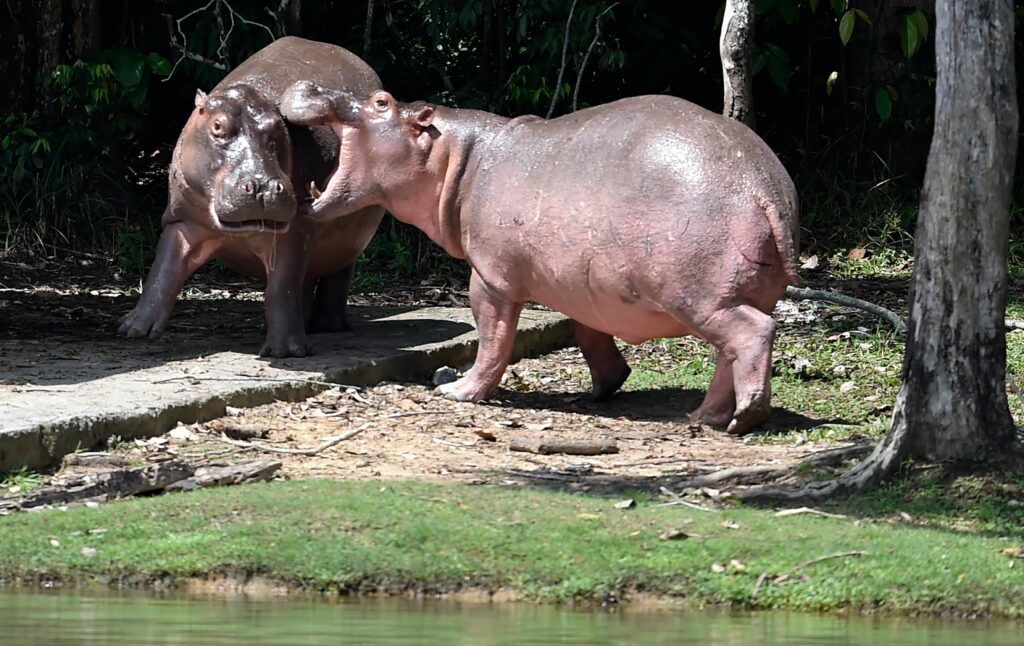Why are there hippos in Colombia?

The presence of hippos in Colombia is a peculiar and fascinating phenomenon that traces its roots back to the infamous drug lord Pablo Escobar. These enormous, semi-aquatic creatures, native to Africa, found an unexpected home in Colombia’s lush landscape, raising questions about their introduction, adaptation, and ecological impact.
Pablo Escobar’s Hippos
Pablo Escobar, one of the most notorious figures in Colombia’s history, controlled a vast empire built upon the illegal drug trade in the 1980s and early 1990s. Among his numerous extravagant possessions was Hacienda Nápoles, a sprawling estate that included a private zoo housing a variety of exotic animals.
Within this menagerie, Escobar introduced four hippopotamuses, originally transported from Africa. Escobar’s fascination with collecting exotic wildlife for his personal zoo was well-known, and the hippos were among the highlights of his collection. These massive creatures, not native to Colombia, found themselves in an unexpected environment far from their natural African habitat.
When Escobar was killed in 1993, many of the animals housed at Hacienda Nápoles were relocated to various sanctuaries. However, the hippos were left to roam freely on the estate due to their size, difficulty in capture, and the costly logistics involved in relocating such large animals.
Hippo Adaptation and Reproduction
Colombia’s environment, particularly the regions surrounding the Magdalena River, offers a habitat similar to the native ecosystems of hippos in Africa. Abundant water bodies, river systems, and swampy terrains provide ample opportunities for these creatures to establish themselves. The warm climate with plentiful rainfall resembles the conditions of their natural habitat, contributing to their adaptability and reproductive success.
With minimal natural predators in Colombia and an environment abundant in resources, the hippos found an ideal setting to flourish. They spend much of their time in water to regulate their body temperature and enjoy the readily available vegetation along riverbanks and marshy areas, allowing for their sustenance and reproduction.
The absence of natural predators and the copious availability of food sources have contributed to a rapid population increase among the hippos in Colombia. Female hippos typically have a gestation period of around eight months, after which a single calf is born. Given favorable conditions, these creatures can reproduce multiple times during their lifetime, leading to exponential growth in their numbers.
Ecological Impact and Challenges
Despite attempts to manage the estate and its remaining animals after Escobar’s demise, the hippos continued to live in the ponds and waterways of Hacienda Nápoles. Unrestricted and without natural predators in this new habitat, the hippos thrived, leading to unexpected consequences that continue to pose ecological challenges today.
The presence of an invasive species like the hippopotamus in Colombia poses significant ecological challenges. Their voracious appetite and ability to dramatically alter ecosystems raise concerns about the impact on native flora and fauna. Hippos consume large quantities of vegetation, leading to habitat degradation and potential competition with native species for resources.
Additionally, the fecal matter of hippos can introduce pathogens and pollutants into water bodies, affecting the water quality and potentially harming other aquatic life. As their population continues to grow, the risk of human-wildlife conflict also increases, posing challenges for local communities and conservation efforts.
Management and Conservation Efforts
Managing the hippo population in Colombia presents a complex challenge. Efforts to control their numbers and minimize their impact on the environment have been underway. Proposals include castration, relocation, and population monitoring to prevent their uncontrolled expansion.
Conservationists and environmental organizations are studying the situation to understand the best methods to address the ecological impact and potential risks posed by the hippos. Balancing conservation efforts with the well-being of local communities remains a critical aspect of any management plan.
The presence of hippos in Colombia stands as an intriguing case study of human influence on ecosystems and the unforeseen consequences of introducing non-native species. As the population of hippos continues to grow, the need for effective and sustainable management strategies becomes increasingly urgent.










